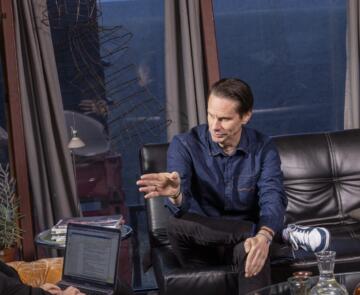
The consumer in control: focus on a personalised news experience
Relevant for everyone
The battle for the reader’s attention is being fought on multiple fronts. “We’re competing not only with other news media but also with social media platforms like Facebook, Instagram and TikTok,” says Jessica. “They use smart algorithms to ensure their content seamlessly fits the world of their target audience. We want our readers to experience the same sense of recognition and relevance with the Mediahuis titles, without ending up in bubbles.”
That’s why Mediahuis is focusing on a more intuitive and personalised news experience. “The user should feel like they are in control,” says Han-Menno. “Through a family subscription, for example, where each family member receives the stories most relevant to them based on a personal profile and their own interests. Or by offering articles in different ways: a short summary for those with little time, an in-depth analysis for others, or even a narrated version. It’s all made possible by AI technology.”

Building on solid foundations
The vision of a more personalised news experience is not just a future goal but a strategic direction that Mediahuis has been developing for some time. In recent years, we have laid crucial foundations to make this vision a reality.
Han-Menno: “We have developed a scalable app architecture based on a central technology platform, enabling personalisation across all our titles. By developing this at group level, each title doesn’t have to do it separately. This is cost- and time-efficient and ensures that the reader gets the same intuitive, relevant and personalised experience with every Mediahuis title."
“Personalisation doesn’t necessarily mean that an algorithm decides what you do and don’t get to see”
In addition to technical infrastructure, Mediahuis has also invested heavily in data science and large language models. “We have been focusing on data maturity for some time and are now at the point of bringing innovations directly to the user,” explains Jessica.
“With the consumer data we have collected online and offline, all very GDPR-compliant, we will soon be able to offer very personal suggestions. If we know that someone is only online with us for 10 minutes in the morning, we can offer a quick news summary. If we notice that someone listens to podcasts between 8.00 and 9.00, we can use a push notification to suggest they listen to tailored articles on the way to work. An app like Waze does the same based on your driving behaviour.”
View beyond the bubble
“Personalisation doesn’t necessarily mean that an algorithm decides what you do and don’t get to see, like on Facebook and TikTok,” she emphasises. “Our journalism remains independent of algorithms and is carefully curated by our editors. You get suggestions based on your interests, but our journalists still decide what content they present and how it looks.”
Han-Menno: “Personalisation is not only in the content but also in the technology. We could grey out articles you've already read, take content that closely matches your interests and make it larger... But we can also give readers the option to request additional context via a ChatGPT-like chatbot or a summary of past articles if you haven’t followed the news for a few days. Not everyone needs in-depth articles every day, but everyone needs news that is relevant and clear.
“This isn’t just about technology. It’s about making sure everyone feels at home in our news environment”
“Suppose you read about the war in Gaza and want to know what exactly happened on 7 October 2023. With one click, you get a short summary that updates you. Or maybe you want a broader perspective: how does NRC view this topic? And how does De Telegraaf? Or a regional title like Gazet van Antwerpen? This way, we get readers out of their bubble and give them a more multi-faceted view of current events.”
In addition, news is becoming increasingly interactive and adaptable. “Readers are getting more control over how they consume news,” says Jessica. “They can set preferred themes, mark important articles for later and fine-tune notifications so they only receive alerts that really matter to them. News is no longer a one-size-fits-all product but a dynamic experience that adapts to the user’s needs and pace.”

News for everyone
With the personalised experience, Mediahuis also wants to reach new target groups. “Not only young people who often consume news via social media today but also, for example, non-native speakers,” says Jessica. “In Belgium or Luxembourg, it is a huge added value if you can switch between the common languages with one click.”
Han-Menno adds: “Older people also remain engaged longer if they can adjust their reading experience: larger text, an adapted layout, a read-aloud function. This is not just about technology. It’s about everyone feeling at home in our news environment.”
The technology may be the means but the goal remains clear: “Strong, independent journalism that feels familiar,” concludes Jessica. “The right content, at the right time, in a way that suits you. That’s what we’re working towards.”

